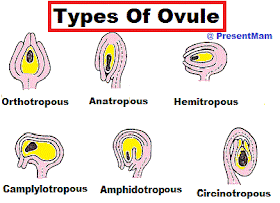Structure of Megasporangium (Microsporophyll = Carpel) :-
also called Ovule=> Structure Of carpel Differentiated Into 3 Part
i) Upper Recepetive Part = Stigmaii) Elongated Tube Like Structure = Style
iii) Lower Swallon part = Ovary
These Are Arrange above the thalamus
@ Structure Of Megasporangium :-
Nucellus :-
Protect Inner Part especially Embryo sac surrounded by two integument . Which present inner side called inner integument & Which present outerside called outer integument
* Portion of embryo where egg found called micropyle . Which help in entry pollen tube
* Back to micropyle end , there is broad part called Chalazal end
* Funicles is the part which help in Attachment of ovule from placenta
@ Types of Ovule :-
1. Orthotropous :-
Straight type ovule , in this ovule micropylar & Chalazal end found opposite to each other in straight line- These type of ovule have Devoid of curvature
2. Anatropous :-
These type of ovule is completely inverted having 180 degree curvature of funicles- In these type of ovule micropyle found near to hilum or faces toward placenta


















